ACC3030 Case Study: Mercedes-Benz All Activity Vehicle Analysis
VerifiedAdded on 2022/07/28
|7
|1290
|34
Case Study
AI Summary
This case study analyzes the strategic management decisions of Mercedes-Benz during the launch of its All Activity Vehicle (AAV). The analysis covers the competitive environment faced by Mercedes-Benz, including key competitors like Ford, Jeep, and GM, and how the company responded to changes in the luxury automobile market. The study examines the linkage between the AAV project and Mercedes-Benz's market coverage strategy, highlighting how the company expanded its operations within the United States. Furthermore, the case explores Mercedes-Benz's cost reduction approaches to achieve target costs, emphasizing the importance of streamlining suppliers and logistics. It also analyzes the significance of suppliers in the target costing process, and the role of the accounting department. The document references various sources to support the analysis, providing a comprehensive overview of Mercedes-Benz's strategic choices and their impact on the AAV project's success.

Running head: STRATEGIC MANAGEMENT
Strategic Management
Name of the Student
Name of the University
Author note
Strategic Management
Name of the Student
Name of the University
Author note
Paraphrase This Document
Need a fresh take? Get an instant paraphrase of this document with our AI Paraphraser
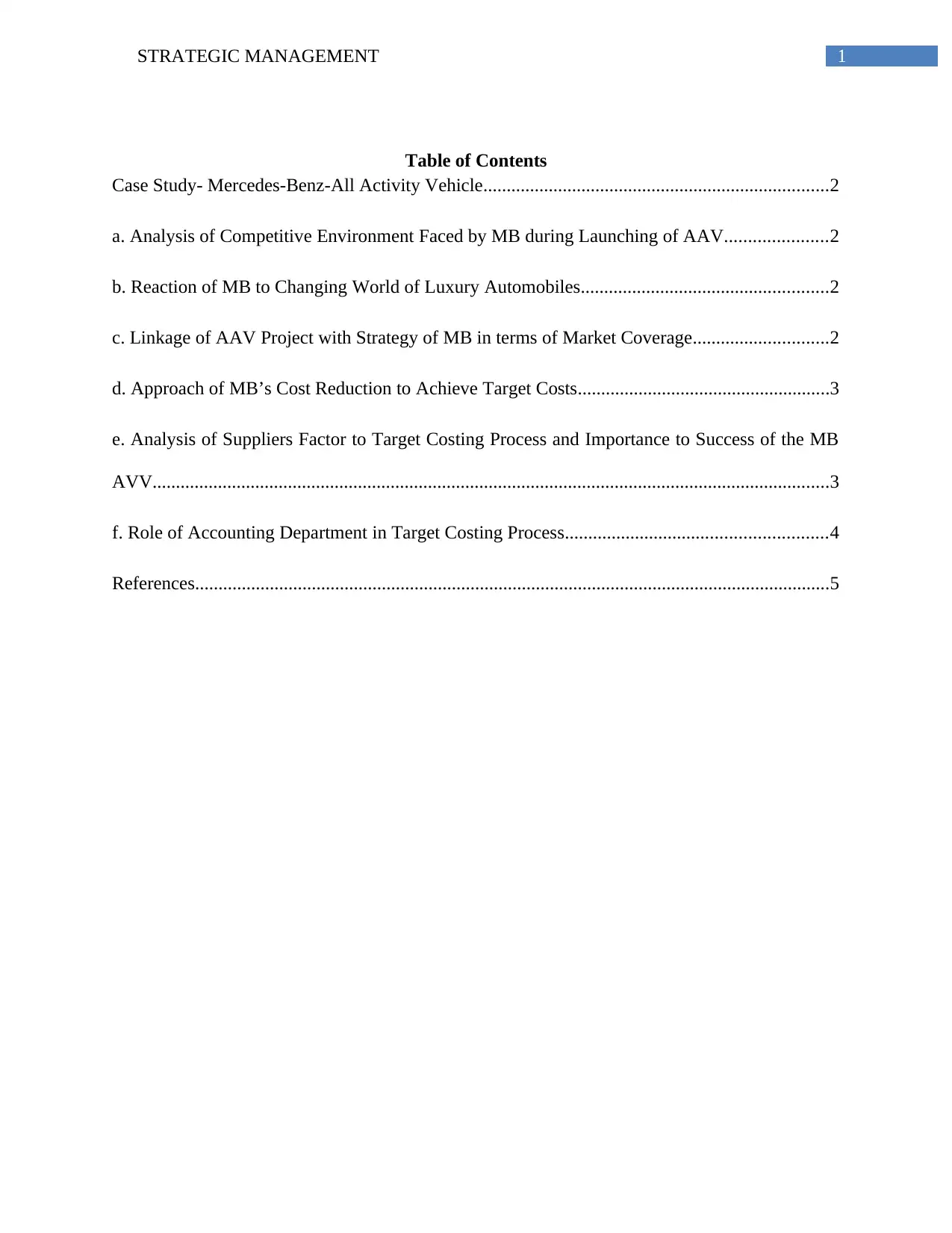
1STRATEGIC MANAGEMENT
Table of Contents
Case Study- Mercedes-Benz-All Activity Vehicle..........................................................................2
a. Analysis of Competitive Environment Faced by MB during Launching of AAV......................2
b. Reaction of MB to Changing World of Luxury Automobiles.....................................................2
c. Linkage of AAV Project with Strategy of MB in terms of Market Coverage.............................2
d. Approach of MB’s Cost Reduction to Achieve Target Costs......................................................3
e. Analysis of Suppliers Factor to Target Costing Process and Importance to Success of the MB
AVV.................................................................................................................................................3
f. Role of Accounting Department in Target Costing Process........................................................4
References........................................................................................................................................5
Table of Contents
Case Study- Mercedes-Benz-All Activity Vehicle..........................................................................2
a. Analysis of Competitive Environment Faced by MB during Launching of AAV......................2
b. Reaction of MB to Changing World of Luxury Automobiles.....................................................2
c. Linkage of AAV Project with Strategy of MB in terms of Market Coverage.............................2
d. Approach of MB’s Cost Reduction to Achieve Target Costs......................................................3
e. Analysis of Suppliers Factor to Target Costing Process and Importance to Success of the MB
AVV.................................................................................................................................................3
f. Role of Accounting Department in Target Costing Process........................................................4
References........................................................................................................................................5
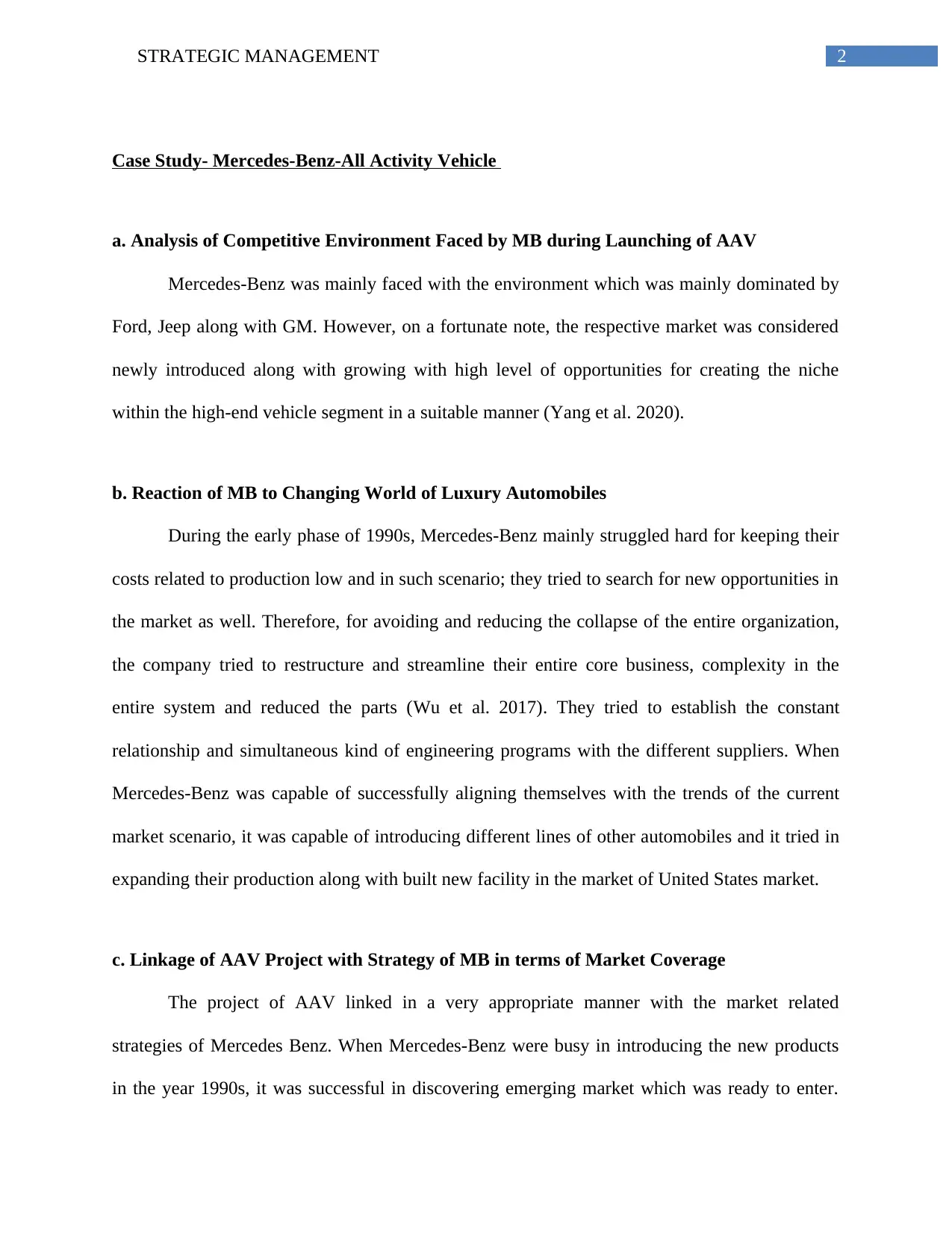
2STRATEGIC MANAGEMENT
Case Study- Mercedes-Benz-All Activity Vehicle
a. Analysis of Competitive Environment Faced by MB during Launching of AAV
Mercedes-Benz was mainly faced with the environment which was mainly dominated by
Ford, Jeep along with GM. However, on a fortunate note, the respective market was considered
newly introduced along with growing with high level of opportunities for creating the niche
within the high-end vehicle segment in a suitable manner (Yang et al. 2020).
b. Reaction of MB to Changing World of Luxury Automobiles
During the early phase of 1990s, Mercedes-Benz mainly struggled hard for keeping their
costs related to production low and in such scenario; they tried to search for new opportunities in
the market as well. Therefore, for avoiding and reducing the collapse of the entire organization,
the company tried to restructure and streamline their entire core business, complexity in the
entire system and reduced the parts (Wu et al. 2017). They tried to establish the constant
relationship and simultaneous kind of engineering programs with the different suppliers. When
Mercedes-Benz was capable of successfully aligning themselves with the trends of the current
market scenario, it was capable of introducing different lines of other automobiles and it tried in
expanding their production along with built new facility in the market of United States market.
c. Linkage of AAV Project with Strategy of MB in terms of Market Coverage
The project of AAV linked in a very appropriate manner with the market related
strategies of Mercedes Benz. When Mercedes-Benz were busy in introducing the new products
in the year 1990s, it was successful in discovering emerging market which was ready to enter.
Case Study- Mercedes-Benz-All Activity Vehicle
a. Analysis of Competitive Environment Faced by MB during Launching of AAV
Mercedes-Benz was mainly faced with the environment which was mainly dominated by
Ford, Jeep along with GM. However, on a fortunate note, the respective market was considered
newly introduced along with growing with high level of opportunities for creating the niche
within the high-end vehicle segment in a suitable manner (Yang et al. 2020).
b. Reaction of MB to Changing World of Luxury Automobiles
During the early phase of 1990s, Mercedes-Benz mainly struggled hard for keeping their
costs related to production low and in such scenario; they tried to search for new opportunities in
the market as well. Therefore, for avoiding and reducing the collapse of the entire organization,
the company tried to restructure and streamline their entire core business, complexity in the
entire system and reduced the parts (Wu et al. 2017). They tried to establish the constant
relationship and simultaneous kind of engineering programs with the different suppliers. When
Mercedes-Benz was capable of successfully aligning themselves with the trends of the current
market scenario, it was capable of introducing different lines of other automobiles and it tried in
expanding their production along with built new facility in the market of United States market.
c. Linkage of AAV Project with Strategy of MB in terms of Market Coverage
The project of AAV linked in a very appropriate manner with the market related
strategies of Mercedes Benz. When Mercedes-Benz were busy in introducing the new products
in the year 1990s, it was successful in discovering emerging market which was ready to enter.
⊘ This is a preview!⊘
Do you want full access?
Subscribe today to unlock all pages.

Trusted by 1+ million students worldwide
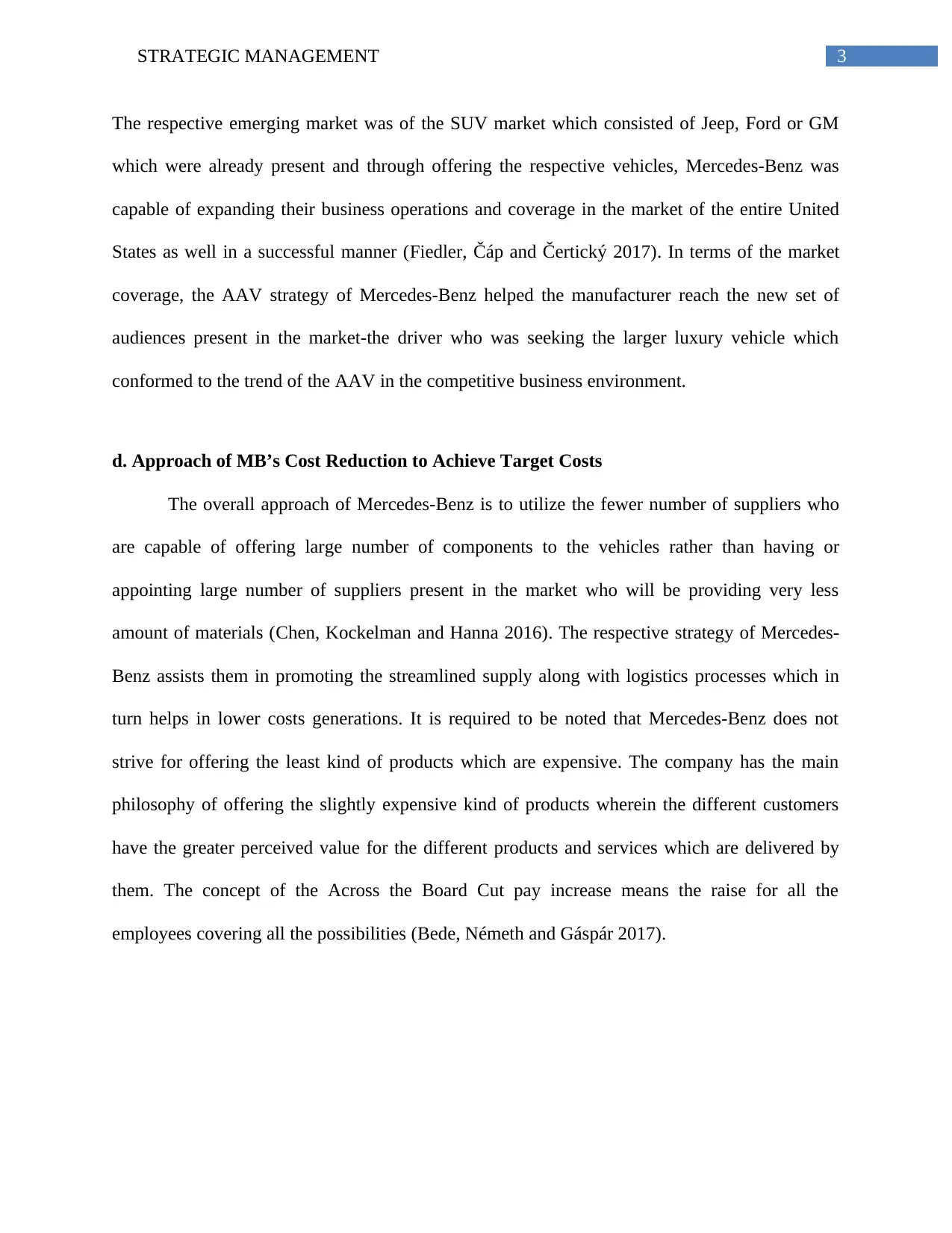
3STRATEGIC MANAGEMENT
The respective emerging market was of the SUV market which consisted of Jeep, Ford or GM
which were already present and through offering the respective vehicles, Mercedes-Benz was
capable of expanding their business operations and coverage in the market of the entire United
States as well in a successful manner (Fiedler, Čáp and Čertický 2017). In terms of the market
coverage, the AAV strategy of Mercedes-Benz helped the manufacturer reach the new set of
audiences present in the market-the driver who was seeking the larger luxury vehicle which
conformed to the trend of the AAV in the competitive business environment.
d. Approach of MB’s Cost Reduction to Achieve Target Costs
The overall approach of Mercedes-Benz is to utilize the fewer number of suppliers who
are capable of offering large number of components to the vehicles rather than having or
appointing large number of suppliers present in the market who will be providing very less
amount of materials (Chen, Kockelman and Hanna 2016). The respective strategy of Mercedes-
Benz assists them in promoting the streamlined supply along with logistics processes which in
turn helps in lower costs generations. It is required to be noted that Mercedes-Benz does not
strive for offering the least kind of products which are expensive. The company has the main
philosophy of offering the slightly expensive kind of products wherein the different customers
have the greater perceived value for the different products and services which are delivered by
them. The concept of the Across the Board Cut pay increase means the raise for all the
employees covering all the possibilities (Bede, Németh and Gáspár 2017).
The respective emerging market was of the SUV market which consisted of Jeep, Ford or GM
which were already present and through offering the respective vehicles, Mercedes-Benz was
capable of expanding their business operations and coverage in the market of the entire United
States as well in a successful manner (Fiedler, Čáp and Čertický 2017). In terms of the market
coverage, the AAV strategy of Mercedes-Benz helped the manufacturer reach the new set of
audiences present in the market-the driver who was seeking the larger luxury vehicle which
conformed to the trend of the AAV in the competitive business environment.
d. Approach of MB’s Cost Reduction to Achieve Target Costs
The overall approach of Mercedes-Benz is to utilize the fewer number of suppliers who
are capable of offering large number of components to the vehicles rather than having or
appointing large number of suppliers present in the market who will be providing very less
amount of materials (Chen, Kockelman and Hanna 2016). The respective strategy of Mercedes-
Benz assists them in promoting the streamlined supply along with logistics processes which in
turn helps in lower costs generations. It is required to be noted that Mercedes-Benz does not
strive for offering the least kind of products which are expensive. The company has the main
philosophy of offering the slightly expensive kind of products wherein the different customers
have the greater perceived value for the different products and services which are delivered by
them. The concept of the Across the Board Cut pay increase means the raise for all the
employees covering all the possibilities (Bede, Németh and Gáspár 2017).
Paraphrase This Document
Need a fresh take? Get an instant paraphrase of this document with our AI Paraphraser
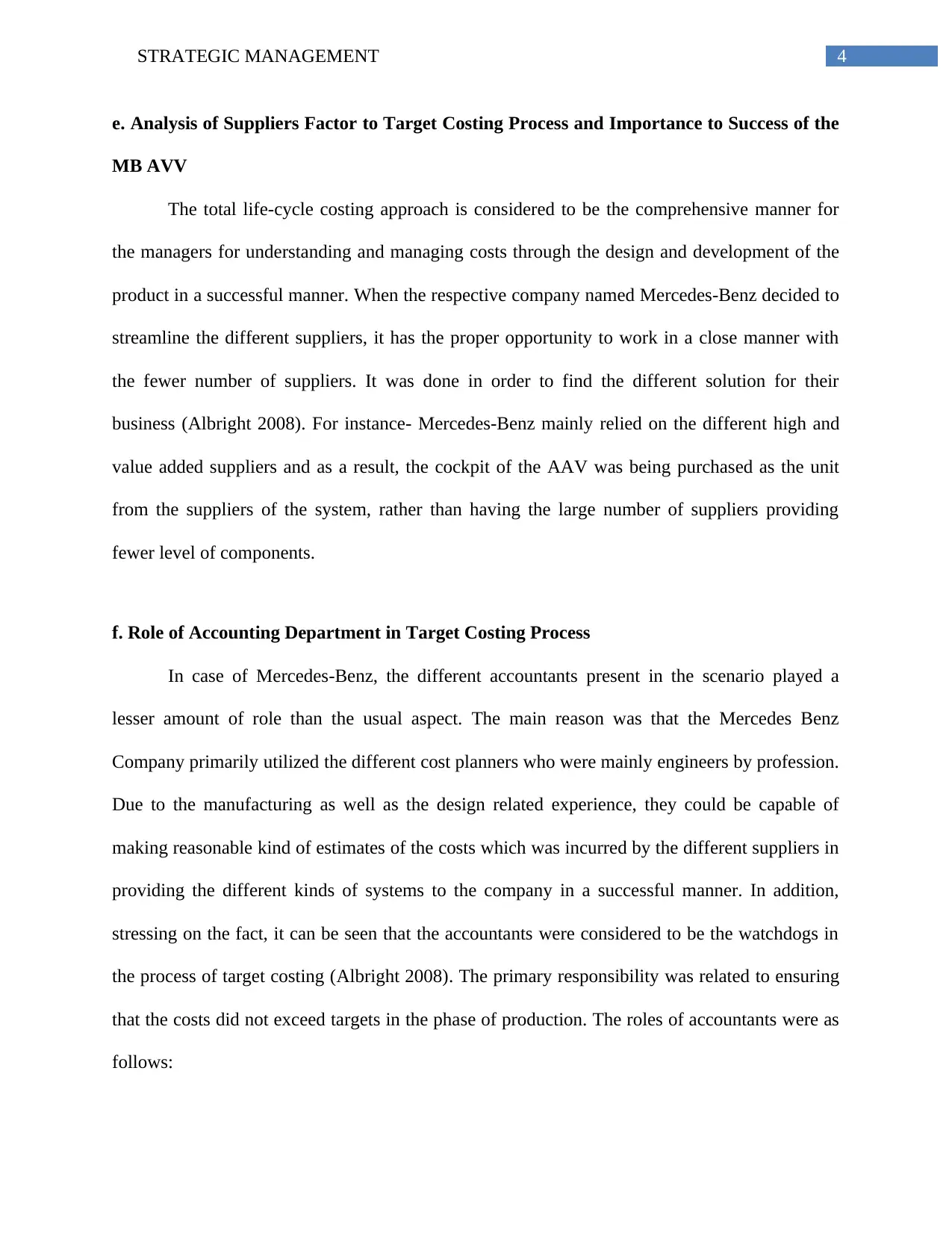
4STRATEGIC MANAGEMENT
e. Analysis of Suppliers Factor to Target Costing Process and Importance to Success of the
MB AVV
The total life-cycle costing approach is considered to be the comprehensive manner for
the managers for understanding and managing costs through the design and development of the
product in a successful manner. When the respective company named Mercedes-Benz decided to
streamline the different suppliers, it has the proper opportunity to work in a close manner with
the fewer number of suppliers. It was done in order to find the different solution for their
business (Albright 2008). For instance- Mercedes-Benz mainly relied on the different high and
value added suppliers and as a result, the cockpit of the AAV was being purchased as the unit
from the suppliers of the system, rather than having the large number of suppliers providing
fewer level of components.
f. Role of Accounting Department in Target Costing Process
In case of Mercedes-Benz, the different accountants present in the scenario played a
lesser amount of role than the usual aspect. The main reason was that the Mercedes Benz
Company primarily utilized the different cost planners who were mainly engineers by profession.
Due to the manufacturing as well as the design related experience, they could be capable of
making reasonable kind of estimates of the costs which was incurred by the different suppliers in
providing the different kinds of systems to the company in a successful manner. In addition,
stressing on the fact, it can be seen that the accountants were considered to be the watchdogs in
the process of target costing (Albright 2008). The primary responsibility was related to ensuring
that the costs did not exceed targets in the phase of production. The roles of accountants were as
follows:
e. Analysis of Suppliers Factor to Target Costing Process and Importance to Success of the
MB AVV
The total life-cycle costing approach is considered to be the comprehensive manner for
the managers for understanding and managing costs through the design and development of the
product in a successful manner. When the respective company named Mercedes-Benz decided to
streamline the different suppliers, it has the proper opportunity to work in a close manner with
the fewer number of suppliers. It was done in order to find the different solution for their
business (Albright 2008). For instance- Mercedes-Benz mainly relied on the different high and
value added suppliers and as a result, the cockpit of the AAV was being purchased as the unit
from the suppliers of the system, rather than having the large number of suppliers providing
fewer level of components.
f. Role of Accounting Department in Target Costing Process
In case of Mercedes-Benz, the different accountants present in the scenario played a
lesser amount of role than the usual aspect. The main reason was that the Mercedes Benz
Company primarily utilized the different cost planners who were mainly engineers by profession.
Due to the manufacturing as well as the design related experience, they could be capable of
making reasonable kind of estimates of the costs which was incurred by the different suppliers in
providing the different kinds of systems to the company in a successful manner. In addition,
stressing on the fact, it can be seen that the accountants were considered to be the watchdogs in
the process of target costing (Albright 2008). The primary responsibility was related to ensuring
that the costs did not exceed targets in the phase of production. The roles of accountants were as
follows:

5STRATEGIC MANAGEMENT
o Control of costs
o Target cost versus actual costs (Development Stage and Production Stage)
o Control of costs
o Target cost versus actual costs (Development Stage and Production Stage)
⊘ This is a preview!⊘
Do you want full access?
Subscribe today to unlock all pages.

Trusted by 1+ million students worldwide
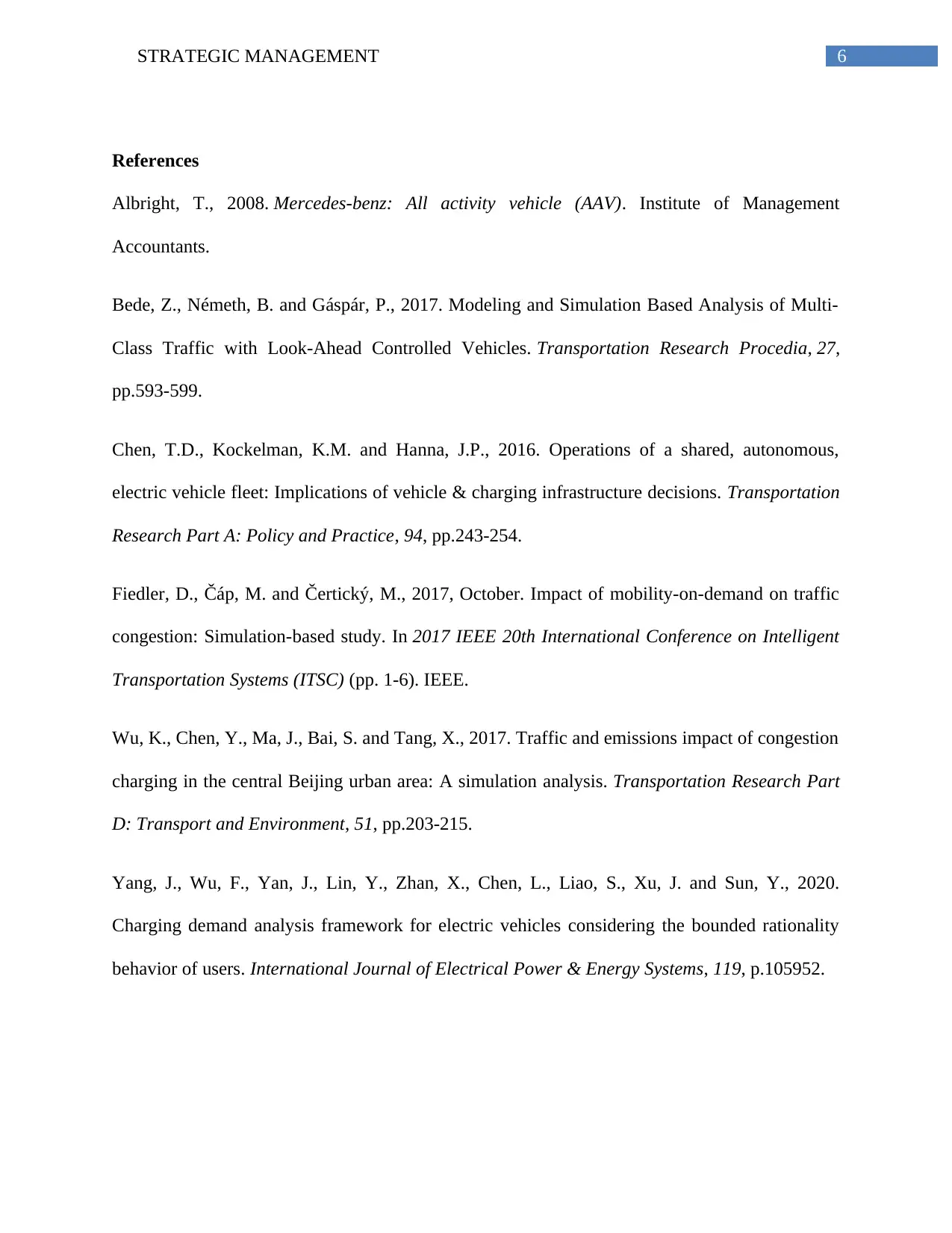
6STRATEGIC MANAGEMENT
References
Albright, T., 2008. Mercedes-benz: All activity vehicle (AAV). Institute of Management
Accountants.
Bede, Z., Németh, B. and Gáspár, P., 2017. Modeling and Simulation Based Analysis of Multi-
Class Traffic with Look-Ahead Controlled Vehicles. Transportation Research Procedia, 27,
pp.593-599.
Chen, T.D., Kockelman, K.M. and Hanna, J.P., 2016. Operations of a shared, autonomous,
electric vehicle fleet: Implications of vehicle & charging infrastructure decisions. Transportation
Research Part A: Policy and Practice, 94, pp.243-254.
Fiedler, D., Čáp, M. and Čertický, M., 2017, October. Impact of mobility-on-demand on traffic
congestion: Simulation-based study. In 2017 IEEE 20th International Conference on Intelligent
Transportation Systems (ITSC) (pp. 1-6). IEEE.
Wu, K., Chen, Y., Ma, J., Bai, S. and Tang, X., 2017. Traffic and emissions impact of congestion
charging in the central Beijing urban area: A simulation analysis. Transportation Research Part
D: Transport and Environment, 51, pp.203-215.
Yang, J., Wu, F., Yan, J., Lin, Y., Zhan, X., Chen, L., Liao, S., Xu, J. and Sun, Y., 2020.
Charging demand analysis framework for electric vehicles considering the bounded rationality
behavior of users. International Journal of Electrical Power & Energy Systems, 119, p.105952.
References
Albright, T., 2008. Mercedes-benz: All activity vehicle (AAV). Institute of Management
Accountants.
Bede, Z., Németh, B. and Gáspár, P., 2017. Modeling and Simulation Based Analysis of Multi-
Class Traffic with Look-Ahead Controlled Vehicles. Transportation Research Procedia, 27,
pp.593-599.
Chen, T.D., Kockelman, K.M. and Hanna, J.P., 2016. Operations of a shared, autonomous,
electric vehicle fleet: Implications of vehicle & charging infrastructure decisions. Transportation
Research Part A: Policy and Practice, 94, pp.243-254.
Fiedler, D., Čáp, M. and Čertický, M., 2017, October. Impact of mobility-on-demand on traffic
congestion: Simulation-based study. In 2017 IEEE 20th International Conference on Intelligent
Transportation Systems (ITSC) (pp. 1-6). IEEE.
Wu, K., Chen, Y., Ma, J., Bai, S. and Tang, X., 2017. Traffic and emissions impact of congestion
charging in the central Beijing urban area: A simulation analysis. Transportation Research Part
D: Transport and Environment, 51, pp.203-215.
Yang, J., Wu, F., Yan, J., Lin, Y., Zhan, X., Chen, L., Liao, S., Xu, J. and Sun, Y., 2020.
Charging demand analysis framework for electric vehicles considering the bounded rationality
behavior of users. International Journal of Electrical Power & Energy Systems, 119, p.105952.
1 out of 7
Your All-in-One AI-Powered Toolkit for Academic Success.
+13062052269
info@desklib.com
Available 24*7 on WhatsApp / Email
![[object Object]](/_next/static/media/star-bottom.7253800d.svg)
Unlock your academic potential
Copyright © 2020–2025 A2Z Services. All Rights Reserved. Developed and managed by ZUCOL.
